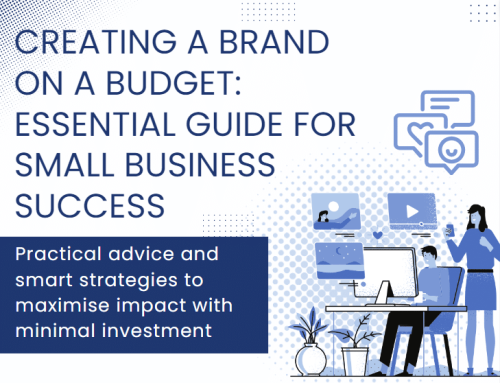7 steps for creating case studies that actually convert
 The latest topic in our Business Marketing Essentials series is case studies.
The latest topic in our Business Marketing Essentials series is case studies.
“Is your service/product/business worth my time and money?” That’s the risk that stops people from buying from you.
And case studies are like a virtual reality answer. Telling a story about a customer’s problem and the solutions you provided gives people a way to virtually try you on. They get a feel for what they can expect to experience when they choose to engage your business.
It sounds very simple and yet so many get this marketing strategy all wrong.
Too often case studies wind up being boring, full of jargon and about anything but the customer.
Done well, a case study allows potential customers to experience their future success – which quite often spells the difference between “maybe” and “where do I sign up?”
We mentor our business coaching clients, particularly those in the B2B space, to build up a collection of thoughtfully researched and well written case studies that will resonate with the ideal customer.
Why case studies are such a great tool for B2B marketing
They build trust
There’s one phrase that has kept coming up throughout this marketing series: social proof. That’s because being able to back up your marketing claims with hard data and testimonials is what will help you earn your customers’ trust.
While customers may not trust you to give an honest account of how your business can solve their problems, research has shown that online reviews and case studies are just as powerful as word of mouth for persuading potential customers to choose your business over the competition.
The reasoning seems to be that if someone is willing to put their own reputation on the line to back your business, then they’re probably telling the truth.
Case studies provide a customer-centric way to showcase your results
A good case study places the emphasis on the client and the outcomes of their project, but it’s also your opportunity to shine. The format lends itself to communicating the positive impacts your business has had in a data-driven, yet easy-to-process way – eg using images, infographics or bullet points. Readers will quickly get a feel for the kind of results they can expect from using your products or service.
Case studies help move customers more quickly through your sales funnel
Gently nudging customers through the sales process is about making a series of revelations and addressing key concerns. By telling a customer’s story from ‘problem’ through to ‘solution and success’, you bypass a lot of that process; a case study goes a long way towards demonstrating the benefits and resolving common questions and objections in one compelling piece of content. That’s a pretty powerful sales tool.
Case studies form unique content
There may be many blogs or LinkedIn posts on any particular topic, but it’s virtually guaranteed that no one else will be telling this particular customer’s story. It’s content that is truly one of a kind.
Seven steps for writing a case study that converts
Step 1: determine your objective – work out what a customer needs to understand about your business in order to be moved towards making a purchase. It’s a good idea to plan your case study themes around their main pain points; what do they need or want most – more time, money, skills etc? Your case study should then address how your business is the best solution to these problems. An easy way to do this is by brainstorming – I often map out these questions with my coaching clients on my whiteboard so it’s easy to see where we have lots of points and where the gaps are.
Step 2: select your case study candidate – think of a past customer who has enjoyed impressive results from doing business with you; one whose story lines up with the objective you selected in step one. It definitely helps if these customers are well-known brands, but it is far more important that you helped them achieve remarkable results.
Make contact and ask the potential subject if they would like to participate. Don’t be shy – many of my business coaching clients have been reluctant to ask for fear that it will be too big an ask of their clients. They’re often surprised at the number of people who actually want to share their story. Remember to gain their permission to feature their story (along with photos etc) in your marketing collateral.
Step 3: research – in addition to your own information about the customer’s experience with your business, you will need to interview them to gain direct quotes that backup the claims you make in your case study. Be sure to prepare questions that will tease out the kind of information and quotes you will need to meet your objective. You should also consider filming or recording the interview to make sure you can quote your subject accurately.
When crafting your questions, make sure you cover off:
- Details about their company (what they do, their goals, the size of their team, how long they have been working with your business etc)
- What problems were they experiencing? (ie that made them seek out businesses like yours)
- What went into their decision-making process? (ie in choosing to do business with your company)
- How did your business solve the problem? (be specific – which products/services did they choose and why? How much time and/or money did they save?)
- How did they implement your product or service? (ie how did your business ‘fit’ into their routines and processes?)
- What results did they see?
Step 4: write a first draft – when our business coaching clients are struggling with ‘blank page’ syndrome, I mentor them to tell a story. The main benefit of this structure is that the human brain doesn’t know the difference between a memory and the ‘theatre of the mind’ that results from great storytelling. If your case study walks the reader through the customer problem, how your business solved it and ends by showing the customer’s success, the reader will have ‘walked a mile’ in your happy customer’s shoes. This creates an ‘experiential’ effect, making the reader feel like they’ve already lived through the process of working with you – and had a great experience!
If you are after a more formal structure, then this is what is most commonly recommended:
- Executive Summary – 2-3 sentences that summarise the customer story (including a statistic about their successful outcome when possible).
- A section on who the case study is about. This should be a paragraph outlining who the customer is, what they do, and how long they’ve been working with your business.
- Outline the problem – what challenges drove them to look for a solution?
- How did your business help? This is your chance to show off how your products or services solved the client’s problems.
- Progress and results – this section should focus on the positive impact your business has had.
Step 5: craft a clear and compelling headline – it’s always a good idea to leave your headline until last. It should grab the reader’s attention and also communicate (at a glance) what they can expect to get out of the case study. For example, does it demonstrate the effectiveness of a particular product or service, or does it speak to the range of industries you serve etc? Try to focus on the single most persuasive benefit for the intended reader and if you’ve got impressive data-driven results, include them in your headline. Eg Company X increases revenue by Y% by doing Z.
Step 6: review and approval – since you are featuring your customer’s story in promotional material, you need to ensure that you are both happy with the results. Make sure that the subject agrees with the way you have presented them and their story and have them check that all details and facts are accurate. Make sure you get formal ‘sign-off’ on the final version in writing.
Step 7: publish and promote – for your case study to work its magic, people will need to know about it. Publishing it on your website (either on a dedicated ‘case studies’ page, or on relevant landing pages) is a great start. However, you’ll also need to promote it to make sure it gets in front of potential clients and customers.
To get your case study ‘out there’, try using it:
- in your company brochure (or other print sales materials)
- in your sales proposal or tender documents
- as part of a sales pitch or presentation
- as a post on LinkedIn or other social media
- as a blog post
- in your email marketing
- as a link in your email signature
Tips for taking your case studies to the next level
- Choose to feature projects or customers that are closest to your ‘ideal’. This way your case study will resonate with the clients and customers you most wish to attract to your business.
- Write for your customer, not for yourself. Only include information that they need and want to know. Also be sure to write using clear, simple language, avoiding corporate speak and internal jargon.
- Pay attention to flow; make the case study easier to read by breaking up large chunks of text with informative headlines and sub-headlines, bullets and visuals.
- Pull out results in a text box or info graphic. Don’t bury it in the body of the text.
- Stats and facts are great, but also include quotes that show the emotional impact your product or service has had on the customer.
- Use customer quotes verbatim, even if they aren’t ‘perfect’. Quotes always feel more credible if they sound like something a real person (rather than a marketing expert) would say.
How to present your case studies
Another important element of your case study is a clean and appealing presentation. If you aren’t much of designer yourself (and don’t have the budget to outsource to a professional), there are templates available that can make DIY case study design a fairly simple process.
Download these free templates from Hubspot to get started.
Case studies: a marketing multi-tool
You’re right if you’re thinking that case studies take a lot of work to create, but they are incredibly valuable pieces of content. The combination of storytelling and data-driven social proof makes them a powerful strategy for getting customers to really experience the value your business offers. Plus, once you’ve got them in the bank, they can be easily re-purposed for many marketing activities, making the time you invest in doing them well worthwhile.
——–




